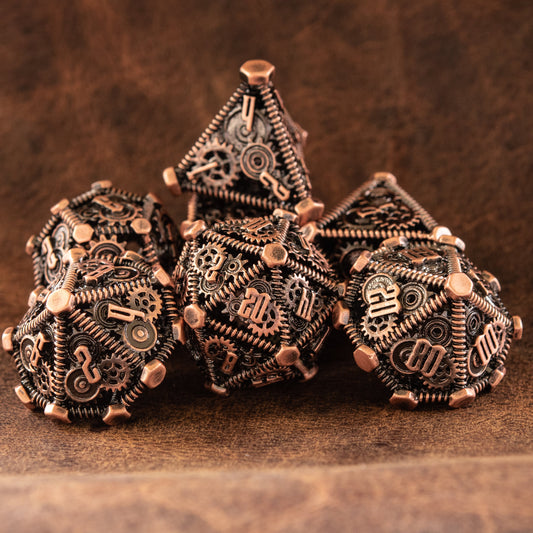Who Invented Dice
Share
Who Invented Dice?
Dice, those small, often cube-shaped objects that we roll to determine outcomes in games, have a long and fascinating history that stretches back thousands of years. While the exact origins of dice are shrouded in mystery, archaeological discoveries and historical records provide us with a glimpse into their ancient beginnings. This article delves into the history of dice, exploring their invention, evolution, and the role they play in modern games like Dungeons & Dragons (D&D).
The Origins of Dice
The invention of dice is a story that spans multiple civilizations and continents. The earliest known dice were discovered in the Burnt City, an archaeological site in southeastern Iran, dating back to around 2800-2500 BCE. These dice were made from animal bones, specifically the knucklebones of sheep or other livestock. Known as "astragali," these early dice were not the six-sided cubes we are familiar with today but rather irregularly shaped objects that could land in various positions.
Similar to the Burnt City findings, ancient dice have been unearthed in other parts of the world, including Mesopotamia, Egypt, and the Indus Valley. In Mesopotamia, dice made from materials such as ivory, bone, and stone have been found in tombs and other archaeological sites dating back to around 3000 BCE. These dice were used in board games, which were popular among the Sumerians and other ancient cultures.
In ancient Egypt, dice were also used in board games, such as Senet, which dates back to around 3100 BCE. The Egyptians crafted their dice from materials like ivory and faience, a type of glazed ceramic. The game of Senet, which involved moving pieces along a board based on the roll of dice, was not only a form of entertainment but also had religious and symbolic significance.
The Indus Valley civilization, which flourished around 2500-1900 BCE in what is now Pakistan and northwest India, also produced dice. These dice were typically made from terracotta and were used in various games, some of which may have had similarities to modern dice games.
The Evolution of Dice
As civilizations evolved, so did the design and use of dice. The six-sided cube, or hexahedron, became the standard shape for dice, likely due to its balance and fairness in producing random outcomes. This design is believed to have originated in ancient Mesopotamia and spread to other cultures through trade and interaction.
In ancient Greece and Rome, dice games were popular among all social classes. The Greeks referred to dice as "kuboi" or "astragaloi," while the Romans called them "tesserae" or "talus." Roman dice were typically made from materials like bone, ivory, and metal, and were often inscribed with numerals or dots to indicate their values. Dice games were a common pastime in Roman taverns and homes, and they were also used in gambling, which was a popular activity in ancient Rome.
The spread of dice continued throughout the Middle Ages, with dice games being enjoyed by people across Europe and Asia. In medieval Europe, dice were often made from bone, wood, and other readily available materials. They were used in a variety of games, including gambling games and board games like backgammon, which has roots in ancient Mesopotamia.
Dice in Modern Times
The invention of modern manufacturing techniques in the 19th and 20th centuries led to the mass production of dice, making them more accessible and affordable. Dice were now made from materials like plastic, which allowed for greater precision and consistency in their design. This standardization was crucial for ensuring fairness in games of chance.
One of the most significant developments in the history of dice came in the 1970s with the creation of Dungeons & Dragons (D&D), a tabletop role-playing game (RPG) that revolutionized gaming. D&D introduced the concept of polyhedral dice, which include not only the traditional six-sided die (d6) but also four-sided (d4), eight-sided (d8), ten-sided (d10), twelve-sided (d12), and twenty-sided (d20) dice. These polyhedral dice are used to determine the outcomes of various actions and events in the game, adding an element of randomness and excitement.
The Role of Dice in Dungeons & Dragons
Dungeons & Dragons, created by Gary Gygax and Dave Arneson, was first published in 1974 and quickly gained a devoted following. The game is set in a fantasy world where players create characters and embark on adventures, guided by a Dungeon Master (DM) who narrates the story and controls the game environment. Dice play a crucial role in D&D, as they are used to determine the success or failure of actions taken by the characters.
The most iconic of these dice is the twenty-sided die, or d20. In D&D, the d20 is used for most of the game's core mechanics, including attack rolls, saving throws, and skill checks. The outcome of a roll can significantly impact the direction of the game, making the d20 a symbol of fate and chance in the world of D&D.
Other polyhedral dice, such as the d4, d6, d8, d10, and d12, are used for various purposes, including determining damage in combat, rolling for hit points, and resolving other game mechanics. Each type of die has its own unique shape and function, contributing to the complexity and depth of the game.
The Cultural Impact of Dungeons & Dragons Dice
The introduction of polyhedral dice in Dungeons & Dragons had a profound impact on the gaming community and popular culture. These dice, with their distinctive shapes and colorful designs, became a symbol of the RPG genre and a staple of tabletop gaming. Collecting and customizing dice became a hobby for many players, with companies producing a wide variety of dice sets in different materials, colors, and designs.
The popularity of D&D and its dice also influenced the development of other tabletop RPGs and board games. Many games adopted the use of polyhedral dice, recognizing their versatility and appeal. The success of D&D and the widespread use of its dice mechanics helped to establish the RPG genre as a significant and enduring part of the gaming landscape.
The Science of Dice
Dice are not just simple gaming tools; they are also objects of mathematical and scientific interest. The study of dice involves concepts from probability theory, geometry, and physics. Understanding the probabilities associated with different dice rolls is essential for game design and strategy.
For example, a standard six-sided die (d6) has an equal probability of landing on any of its six faces, with each face having a 1 in 6 chance (approximately 16.67%) of being rolled. However, when using multiple dice, the probabilities become more complex. For instance, rolling two six-sided dice and summing their results produces a probability distribution where some outcomes are more likely than others. The most common result is 7, which has a probability of 1 in 6 (approximately 16.67%), while the least common results are 2 and 12, each with a probability of 1 in 36 (approximately 2.78%).
Polyhedral dice, such as those used in Dungeons & Dragons, have their own unique probability distributions. For example, a twenty-sided die (d20) has an equal probability of landing on any of its faces, with each face having a 1 in 20 chance (5%) of being rolled. Understanding these probabilities is crucial for players and game designers, as it affects gameplay and decision-making.
The design and manufacturing of dice also involve scientific principles. Precision and balance are essential to ensure fair and random outcomes. Modern dice are often manufactured using injection molding and other techniques that allow for high levels of accuracy and consistency. Quality control measures, such as testing for weight distribution and symmetry, help to ensure that dice perform as expected.
The Art of Dice
Dice are not only functional objects but also works of art. The design and aesthetics of dice have evolved over time, with artisans and manufacturers creating dice that are both beautiful and unique. From intricately carved bone and ivory dice in ancient times to modern dice made from materials like metal, resin, and gemstone, the artistry of dice is a testament to human creativity and craftsmanship.
In recent years, the popularity of Dungeons & Dragons and other tabletop RPGs has led to a resurgence of interest in custom and artisanal dice. Many players seek out dice that reflect their personal style and preferences, leading to a thriving market for handmade and custom-designed dice. These dice often feature intricate patterns, vibrant colors, and unique materials, making them highly sought after by collectors and enthusiasts.
The artistic appeal of dice extends beyond their physical design. Dice have become symbols of adventure, storytelling, and imagination. They represent the thrill of uncertainty and the excitement of possibility, capturing the essence of what makes games like Dungeons & Dragons so compelling.
The Future of Dice
As we look to the future, the role of dice in gaming continues to evolve. Advances in technology have introduced new possibilities for dice design and functionality. For example, electronic dice with built-in LEDs and sensors can provide dynamic lighting effects and interactive features, adding a new dimension to tabletop gaming.
The rise of digital gaming has also influenced the use of dice. Virtual dice rollers and digital RPG platforms allow players to roll dice and resolve game mechanics online, making it easier to play games remotely. However, the tactile experience of rolling physical dice remains a cherished aspect of tabletop gaming, and many players continue to prefer the feel and sound of rolling real dice.
In conclusion, the invention and evolution of dice are a testament to their enduring appeal and significance in human culture. From their ancient origins to their role in modern games like Dungeons & Dragons, dice have captured our imagination and provided countless hours of entertainment. As we continue to explore new frontiers in gaming and technology, the humble die remains a symbol of chance, adventure, and creativity.


